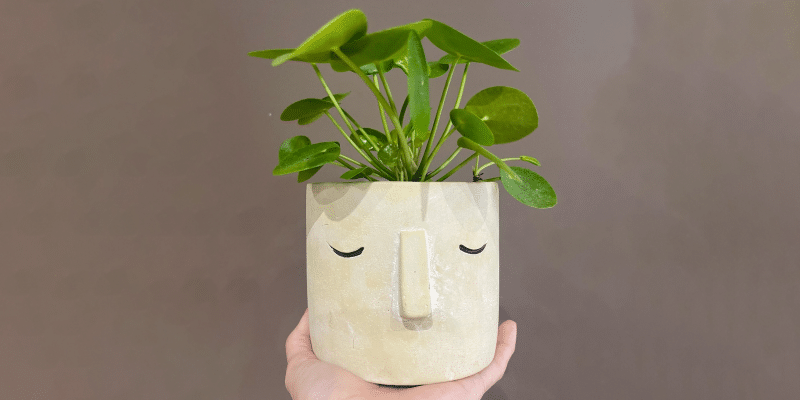Chinese money plant (scientific name Pilea peperomioides) is a popular houseplant finding itself featured prominently in Scandi design and homes throughout the world.
Even compared to other houseplants, the Pilea plant is easy to care for, with only a few tricks up its sleeves.
(Mostly related to watering.)
In this article, we’ll take you through everything you need to know about Pilea peperomioides.
We have tips. We have tricks. We have… actually a lot of experience growing Chinese money plants indoors, so we’ll cover the most common issues that you might have with them and how to resolve them fast.
(It’s also a super easy indoor plant to propagate.)
Table of Contents
Chinese Money Plant Care Guide
History, habitat, and characteristics
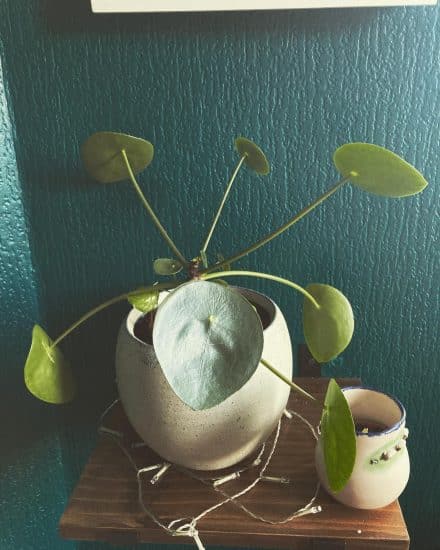
The Chinese money plant, Pilea peperomioides, has become a signature piece of interior design for its low-maintenance qualities, statement-making leaves, and diverse characteristics. Its story begins in South China’s Yunnan Province, but now its unique foliage and calming presence have made it an exceptionally popular plant in Scandinavian, and in turn modern Scandi, interior design.
Known as the pancake plant, UFO plant, or coin plant, this is a really gorgeous, easy-to-care-for houseplant.
They grow quite quickly and easily. During its growing season, it may even produce small flower clusters that range from cream to pink, but its bright leaves are its most remarkable feature.
There’s also a cute story that the reason we see this plant so often in Scandi design is that a single Norwegian missionary brought it back to Europe and gave cuttings away to his friends. I’ve also heard that the missionary plant name comes from how easy it is to propagate, because just like a spider plant, it produces lots of little pups and offshoots that are incredibly easy to just pick up and replant.
Light
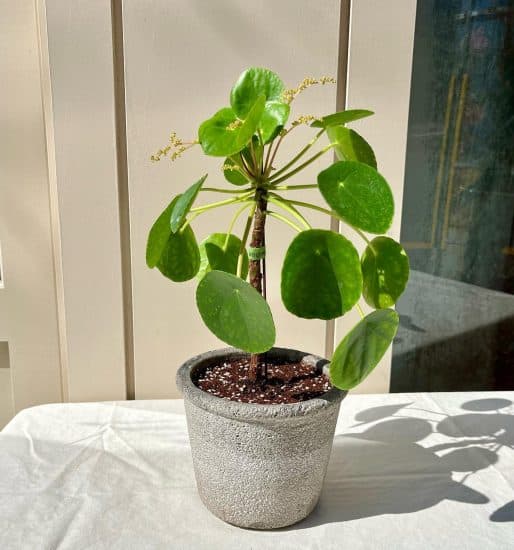
Although the Money Plant requires a lot of light, it can survive in lower light settings, but may become leggy and grow fewer offshoots with smaller leaves.
So, how much light does a Chinese Money Plant need?
This plant can really take a lot of light. We recommend plenty of bright indirect light, and even a couple of hours of direct sunlight will really encourage this plant to grow. This means an area that receives lots of natural, diffuse daylight.
In lower light, you’ll notice growth slowing down, leaves becoming darker, and a more stretched out and leggy look instead of full and bushy.
Too much direct sun can scorch and burn their leaves very easily. If you only have a spot with lots of direct sunlight, consider using a sheer curtain to create a filter, or group some plants that love direct light in front of it to create a lil canopy of shade.
You’ll want to keep the leaves of your Pilea plant clean, as dust can prevent them from photosynthesizing effectively. If your light is already slightly limited, dust and dirt can cut it even more, plus they’ll clog those delicate stomata and make gas exchange and water regulation even less effective.
Pilea peperomioides can be trained to grow straight, but you’ll have to rotate them almost daily because they tend to grow towards light. You really want these plants to get light from all sides if possible to prevent them from becoming asymmetrical and lopsided.
You can also give your Pilea a bamboo pole so that it can climb and get some additional support.
Lighting summary for Pilea peperomioides:
- Lots of bright sunlight with a quarter rotation a day for a full, bushy look
- Can survive in low light but will grow slowly and show darker leaves
- If kept in direct light, you’ll notice scorching on the leaves
- If the plant is receiving enough light, it should retain its flat, coin-shaped leaves
- If the plant is receiving too little light you’ll notice droopy, extended stems or leaves that stretch outwards from the stem
If symptoms like bleaching or yellowing leaves appear, be sure to move the plant to a partially shaded spot with indirect light and reduce the amount of sun it is exposed to.
Water
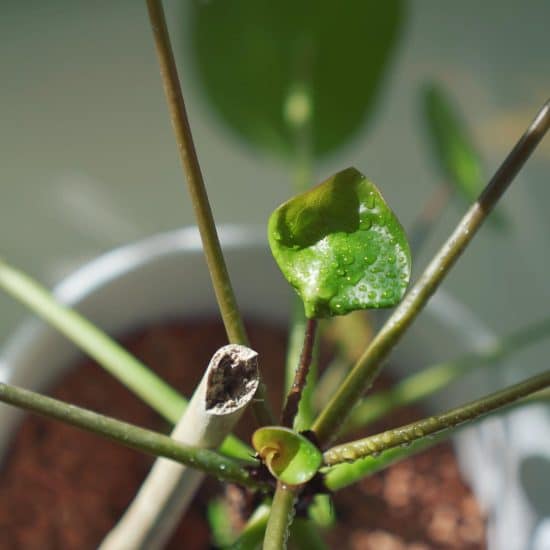
The best rule of thumb is to water your Pilea plant when the top of the soil is dry. To test this, stick your finger two to three inches into the soil. If it feels cool and slightly moist, you can wait at least 2-3 days before watering again. If it feels dry, it is time to water.
Why do we let the top few inches of soil dry out? In most containers, it’s a good proxy for the overall moisture content of the soil, and this houseplant doesn’t want to sit in completely dry soil for too long.
In the soil, there are fungi lurking, some of them beneficial to your plant. When we overwater a plant or use dense, compacted soil, the root system becomes a lot weaker. Simultaneously those fungi are growing in the moisture, and this is a recipe for root rot.
(We’ll cover how to deal with this if you do have it later on.)
If you want more specificity than just “it feels… dry” you can use a moisture meter, but for most plants, they aren’t necessary.
If you see your Pilea plant’s leaves drooping, this is a pretty clear sign there’s an issue somewhere — but unfortunately, this can be caused by both overwatering and underwatering. Although this might sound pretty frustrating, it’s actually a great clue!
Time for a little bit of general houseplant care theory: if you can isolate any problem your plant is having to a specific area of care (like watering), you’ve really eliminated a lot of potential causes. So with drooping leaves, for example, you can now just check that soil or think about whether you’ve watered it lately.
If you watered yesterday and its leaves started drooping right after, you can be pretty certain that the potting mix is either retaining too much water or your frequency is a bit off. If you notice those leaves hanging down and the soil is dry? You get the idea.
You’ll want to use filtered water because tap water can create small holes in your leaves and leave damage that pests will infiltrate through. If you are organized enough to have a rain collector, this is the perfect water for this plant. If not: filter!
Temperature and humidity
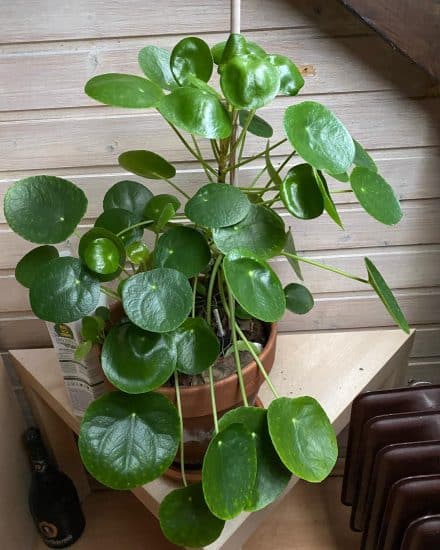
When it comes to taking care of a Chinese Money Plant, think of it like a house party (bear with me): too much heat and humidity, and things get uncomfortable, but just the right balance, and everyone’s having a great time (including your plant).
It’s not that difficult to master the balance between temperature and humidity, so let’s talk about the details of throwing the best shindig.
Temperature is the main event at this party, and your plant shouldn’t have to fear a chill. Anywhere from 60 to 85 degrees will be just fine — aim for the middle. Pilea peperomioides can suffer in cool temperatures, especially if there’s a sudden draft, so try to keep the temperature pretty stable. If you bring this plant outside in the spring or summer, make sure to bring it back in once it starts to get cooler overnight.
Now on to the after-party: humidity. You’re going to want 40% or higher, ideally above 50%. If you don’t have a hygrometer (they’re actually pretty inexpensive, you might be surprised), you can assume most households are going to be in this range, so you’re in luck!
If you know that your home’s humidity is a bit lower than normal, or if you run the furnace a lot in the winter, you might need some strategies for raising that moisture. Don’t worry, we have a few.
To raise your humidity:
- Most obviously: a humidifier. You can buy small ones that don’t use up much electricity and that are super cute.
- Grab a tray, fill it with some rocks and cover them with water: you’ve made your first pebble tray! As the water evaporates from the surface area of the tray, you’ll raise the humidity around your plants without making your home too uncomfortable. (As a bonus, they’re also really cute).
- Group your plants together, especially those that want similar humidity levels. Even within a few hours, transpiration is going to raise the local humidity levels as water evaporates from their leaves.
Soil and planting
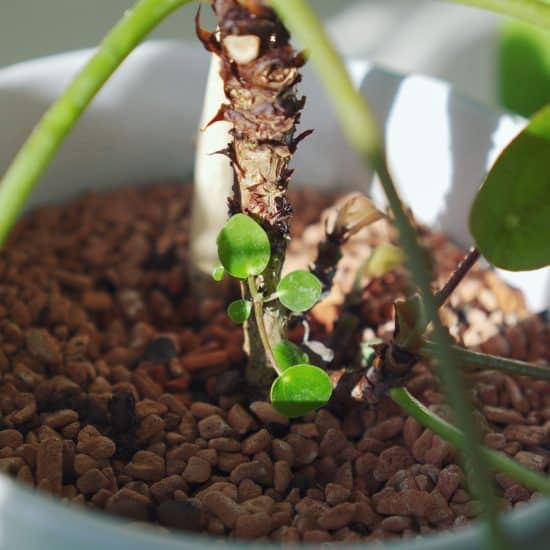
Pilea peperomioides (pancake plant) really wants potting soil with good drainage, but it’s not any pickier than most tropical plants that have found themselves living as houseplants.
I can recommend our standard mix:
- 50% potting soil
- 40% succulent soil
- 10% perlite/pumice
This is going to keep the soil well-aerated and fast draining, while also providing the nutrition your Chinese money plant needs.
Speaking of nutrients, you can fertilize this plant throughout the growing season. Many people think that’s just spring and summer, but if you notice leaves growing, you can happily use fertilizer.
I recommend using a balanced liquid fertilizer at 50% dilution. If you haven’t fertilized this plant before, you can start small (70-80% dilution, even) and increase over time to see how the plant responds.
For repotting, you’ll typically go one size up while it’s actively growing (spring/summer are great). If the plant goes into shock and looks a bit sad right after, this is pretty normal and you don’t need to change your care at all.
You’ll know it’s time to repot because you’ll just run out of soil for all of the pups from the mother plant. You can hold off on fertilizing for the first few months after repotting, since there should be plenty of nutrients in the soil.
Your pot needs to have a few drainage holes so that the roots don’t sit in standing water. You’ll still want to use a decorative pot — just size it appropriately so one can sit in the other, and make sure excess water isn’t pooling in your outer pot.
Propagation guide
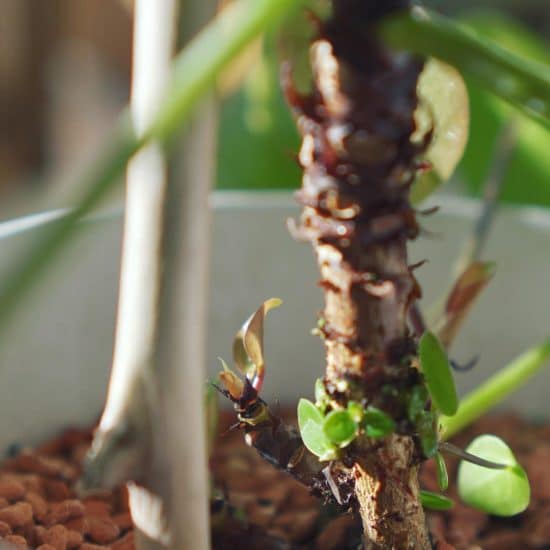
There are so many ways to propagate your Pilea plant. We’ll cover a few different methods, but the easiest method by far is just relying on those pups.
Pilea pups are the mini-plants you’ll see them produce in the soil. We’ll cover how to divide them off of the mother plant.
Propagating Pilea peperomioides by division:
- Begin by selecting the pup/offshoot of the mother plant.
- Prepare a pot with a fertile soil mix, making sure to keep it moist but not drenched.
- Place the pup/offshoot in the prepared pot and put it in a humid and warm location, away from direct, bright light.
- Regularly check for root growth to monitor the progress of your new plants, and then transfer the pup/offshoot to a bright, sunny location for further growth.
- Provide a similar light and humidity environment to the one enjoyed by the mother plant.
- Keep the soil moist and maintain the correct humidity levels (50 to 60 percent), and you should be successful in propagating your new plant.
Propagation is also great if you notice your plant isn’t doing that well. In most cases, you can take cuttings and start all over again, especially if there’s an issue with rot or the soil.
Propagating Pilea peperomioides by leaf cuttings:
This is another really easy propagation, although it might work a bit differently than how you normally take a leaf cutting. You’ll need a sterilized knife to start
- Find a healthy single leaf, preferably one of the mature leaves at the bottom of your plant.
- You’ll trace the petiole (the part coming out of the leaf) down to the stem.
- Make a cut past the petiole into the stem. You’ll carve out a bit of this stem as you separate the petiole.
- Place your cutting in a container with filtered water and wait 3-4 weeks. Once you see roots that are around 3 inches long, you can transplant into soil.
- Give your new leaf-cutting high humidity (you can place Tupperware or glass over it to create a mini terrarium) and plenty of bright light as it takes root over the next few weeks.
Congratulations, you have a new friendship plant!
Common issues
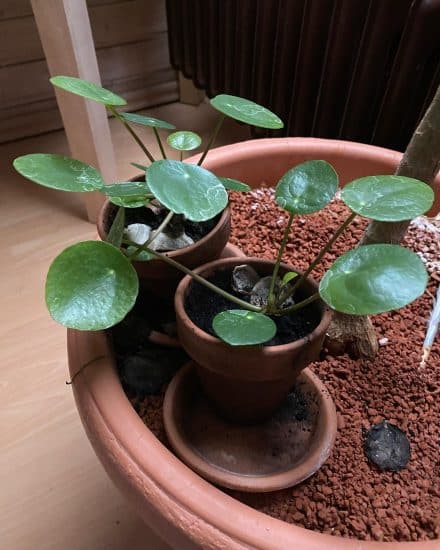
Chinese money plant care isn’t without its issues, and we’ll cover the two issues we get the most questions about.
Yellowing leaves
Yellowing leaves are almost always caused by overwatering, and not just too much water, but a lack of drainage. Often, we’ll see compact, heavy soil, a lack of drainage holes, or watering just far too frequently.
You’ll want to make sure you have soil that’s well-aerated so that both water and air can make it through.
If your leaves are mostly yellow at the bottom of the plant, look pale, and aren’t falling off, this could be a lack of nitrogen.
The solution: you’ll want to try some liquid fertilizer if you aren’t using it (look for 10-10-10). If the leaves perk up, you’ve identified the issue.
Curling leaves
If your Chinese money plant leaves are curling inwards, this is almost always from too much direct sunlight. It’s fine for the plant, and usually won’t permanently damage or kill it, so don’t stress out about sun stress. If you see new growth at the top of the plant or new babies propagating on their own at the bottom, these are good signs.
The solution: add a curtain or back the plant away from the window a bit.
If this doesn’t fix the issue, you’ll want to make sure you aren’t moving the plant around a lot, or that it’s not parked next to a radiator or AC. Keep those temperatures stable!
(In some cases, this can look like brown spots or patches, too.)
By taking these steps and caring for your Pilea peperomioides properly, it will remain healthy and vibrant for years to come.
Diseases and pests
The Chinese money plant can have some trouble with staying wet and too much moisture on the leaves and soil. Let’s cover what might come up and how to fix it fast.
Root rot
Root rot is usually caused by an issue with either the soil or overwatering. If you see yellowing leaves that are falling off, moist soil, or the plant has been sitting in standing water, this is unfortunately a likely outcome.
You’ll want to examine the roots and cut off any that look dark and slimy with sanitized shears. Replant in fresh potting soil that’s fast draining (check our recommendations in the soil section) and make sure the pot you use has drainage holes.
Try watering when the soil just starts to feel dry a few inches down.
Spider mites
Spider mites are another pesky problem that can affect the Chinese money plant, especially if the environment becomes too dry.
(Unlike our last issue, mites really hate moisture).
You’ll know they have infested your plant if you spot fine webs covering the leaves. By this point, you usually have thousands upon thousands. If you can stand to, grab a magnifying glass and be… in awe.
You’ll want to rinse them off outside and apply soapy water or neem oil. With neem oil, you can reapply every few weeks for a month or so, including on the soil.
Conclusion
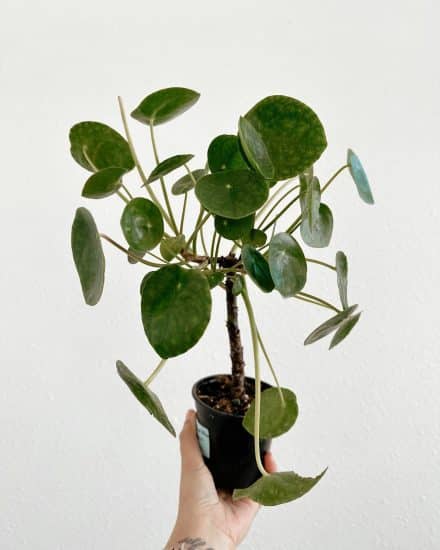
Pilea peperomioides (Chinese money plant) is an easy houseplant to keep with beautiful circular leaves that add an extra boost of tranquility to any home.
Propagating is so easy — the baby plants basically grow themselves! But leaf cuttings work well too.
Pilea Peperomioides care summary:
- Chinese money plants love bright light, but too much direct sun, or you’ll see curling leaves and scorch marks.
- If you see your root system starting to come out of a drainage hole, this is a sure sign that it’s time to repot, even just to ensure you still have proper drainage.
- Chinese money plants can be propagated by division or leaf cuttings, and both take around 3-4 weeks for new roots to take hold.
- If you are routinely overwatering this plant, consider adding perlite, pumice, or LECA to increase aeration, or switch to a terracotta pot.
That’s it for our guide! We really hope this article was useful for you guys. If it was, consider sharing it with a friend. And send in some pictures of your Pilea peperomioides — we love to see the plants you grow!
As always: take care!
FAQ
Where should I put my Chinese Money Plant?
Honestly, anywhere you want to!
Your Chinese money plant is going to be happy with a lot of indirect light, but it can do well in lower light or even a bit of direct sunlight (such as from a south or west-facing window).
Why is Pilea peperomioides called a Pancake plant?
Pilea peperomioides is commonly referred to as a Pancake plant due to the shape and appearance of its flat, round leaves. This adorable plant is also sometimes called the “UFO plant” because of its unique, otherworldly appearance.
How can I get a full, bushy Pilea plant?
The key is keeping each baby plant in the same container. Most of these bushy plants you see on Insta are actually many plants tied together on a pole, because naturally they want to droop and hang down a bit. If you do train them on a pole, you can often remove it later as they’ve grown to support their new taller lifestyle.
Do Pilea like to be misted?
Generally avoid misting the leaves of your Pilea peperomioides, as this can promote fungus and some pests, and doesn’t do much for humidity.
Are Pilea peperomioides safe for pets?
The ASPCA considers Pilea peperomioides non-toxic to cats and dogs.

